Avoid Dark Patterns Cookie Banners: Honest and Ethical Design for Compliance
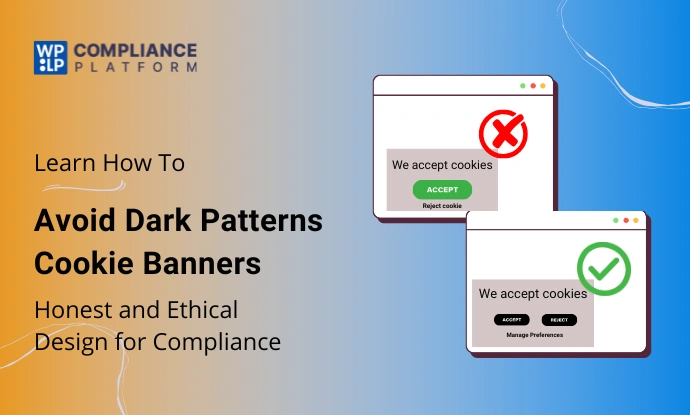
Summary
To deliver the best user experience, the WPLP Compliance Platform allows you to gather consent in multiple languages, transparently and lawfully, without relying on manipulative dark patterns.
Could your consent banner be exposing you to fines or eroding user trust?
What may appear as a simple cookie notice is a legal risk, especially if it incorporates dark patterns.
Dark patterns trick people into taking action on a website that they did not intend to.
In this article, you will be guided through the dark patterns, and we will help you create honest cookie consent banners that not only meet the expectations of privacy laws (like GDPR and CCPA), but also treat the user fairly.
We will outline the principles of ethical consent design and introduce platforms that are simple and trustworthy.
- What Are Dark Patterns in Cookie Consent?
- Why Dark Patterns Cookie Banners Harm Users and Your Compliance
- Laws & Regulations Targeting Dark Patterns
- Elements of Honest and Ethical Cookie Consent Banner Design
- Best Practices for Compliant, User-Friendly Consent UX
- How WPLP Compliance Platform Enables Honest Consent
- Real-World Examples: Dark Patterns vs. Honest Design
- Frequently Asked Questions (FAQ)
- Conclusion
What Are Dark Patterns in Cookie Consent?
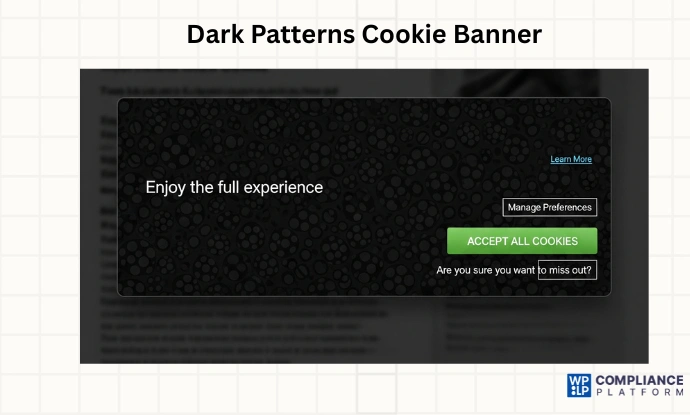
Dark patterns mislead users into making unintended decisions. It can be making a purchase, signing up for newsletters, or sharing any personal information.
In the context of cookie banners, these patterns are designed to encourage users toward accepting all cookies, even when they don’t want to.
Unlike good user interface (UI) design, these practices benefit the business at the expense of the user’s choice. Some dark patterns cookie banners make users frustrated when they are attempting to cancel an account or close a pop-up, and it is not working.
These patterns also push users into sharing more data than intended, such as disguising location tracking as an opt-out instead of an opt-in.
Some common dark patterns in cookie banners are:
- Pre-ticked boxes
- Hidden reject buttons
- Misleading copy
- Forced consent (“cookie walls” )
- Visual trickery
Regulatory bodies such as the European Data Protection Board (EDPB) and CNIL (France) have explicitly cautioned against these types of practices, emphasizing that consent must be free, specific, informed, and unambiguous.
Why Dark Patterns Cookie Banners Harm Users and Your Compliance
The goal of consent banners is to provide website users control over their data collection and usage. For users to make informed choices about their data, website owners must be transparent, truthful, and forthright in their consent banner about the data that is collected.
Using dark patterns in cookie banners leads to loss of users’ trust.
However, choosing dark pattern cookie banners may get you a high acceptance rate for your banner, but there are some consequences of using these patterns.
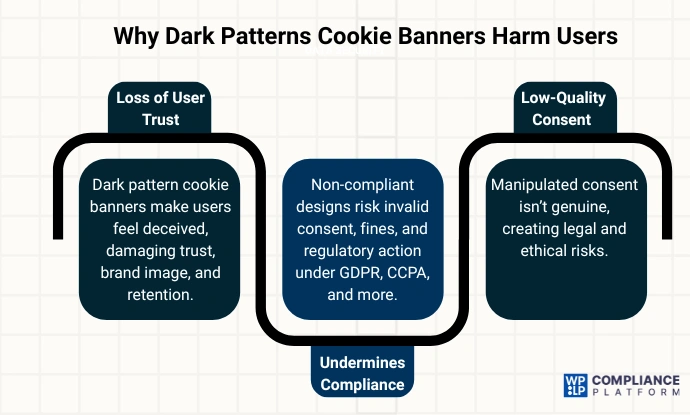
1. Loss of User Trust
Trust is a foundational aspect of any successful relationship between an organization and its users. Dark patterns cookie banners cause users to feel deceived and manipulated, and this leads to trust being compromised.
If a user lands on your page and is unable to reject the cookie easily, they will feel uneasy and will end up leaving the page.
This leads to negative brand image, a higher bounce rate, and a decrease in repeat visits.
2. Undermines Compliance
Regulators are becoming stricter on dark patterns.
The French data protection authority, CNIL, fined Google and Meta for making it difficult for users to refuse cookies.
Similarly, the UK’s ICO has issued warnings about non-compliant banner designs.
Utilizing a dark pattern may also invalidate the consent you’ve gathered, which puts you at serious risk of severe fines based on regulations like GDPR and CCPA.
3. Low-Quality Consent
Consent obtained through manipulation isn’t genuine. It’s not a reliable basis for processing personal data, which could lead to legal challenges.
DPAs throughout Europe have been increasing the number of sites examined (the UK’s DPA, the ICO, announced in January 2025 that it is expanding the number of sites it will review this year).
DPAs have been issuing formal warnings (and some sizable fines) to sites they view as misleading, pressuring, or tricking users into sharing data using dark patterns.
At the end of 2024, for instance, the Belgian DPA threatened daily fines of 25,000 euros for continued noncompliance with 4 press websites for using dark patterns in their consent banners.
Laws & Regulations Targeting Dark Patterns
Governments and regulations are taking several steps against UX practices and dark patterns, including cookie banners that websites are following.
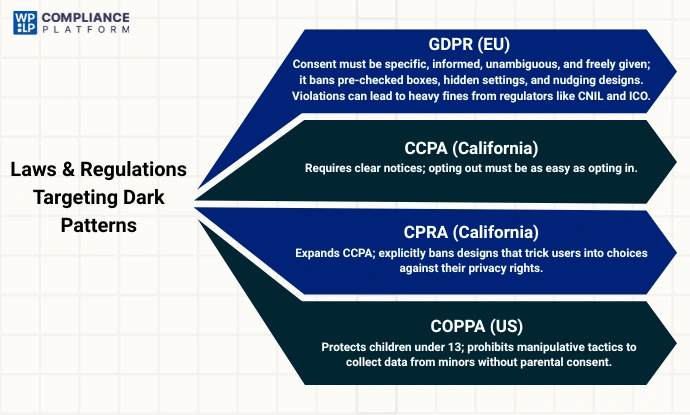
General Data Protection Regulation (GDPR)
The GDPR (General Data Protection Regulation), which is applied to the European Union, states that user consent for data processing must be specific, informed, unambiguous, and “freely given.”
This means companies cannot rely on dark patterns to obtain permission.
Patterns that pressure users into agreeing to data collection are considered a violation of the GDPR and can result in significant fines.
Enforcement bodies like France’s CNIL and the UK’s ICO have issued warnings and penalties to companies for using such tactics, particularly in cookie banners that make it much easier to accept than to reject cookies.
The California Consumer Privacy Act (CCPA)
The CCPA (California Consumer Privacy Act) requires companies to provide clear notice of their data collection practices and consumer rights.
A key provision is that opting out of data sales must be as easy as opting in, preventing any manipulative designs that confuse consumers into opting out.
California Privacy Rights Act (CPRA)
The California Privacy Rights Act (CPRA), which expanded the CCPA, takes an even more decisive action.
It clearly defines dark patterns as designs that trick or confuse people into making choices that go against their privacy rights.
The CPPA Agency oversees these regulations and can charge you significant fines and penalties for violations. It also issued advisories to businesses to ensure they provide symmetrical choices and simpler, plain language.
The Children’s Online Privacy Protection Act (COPPA)
Designed to protect children under 13, the Children’s Online Privacy Protection Act (COPPA) prohibits companies from collecting personal information from minors without verifiable parental consent.
Dark patterns can easily violate this law by pushing kids to share data, tricking kids into buying things, and keeping kids on screens too long.
In situations where companies do not adhere to COPPA, the Federal Trade Commission (FTC) has to impose high penalties because they are using dark patterns on sites geared towards children.
With regulators taking notice of these deceptive practices, let’s look at how laws specifically address dark patterns.
Elements of Honest and Ethical Cookie Consent Banner Design
Designing an ethical and honest cookie consent banner is crucial.
The motive is to empower users and not manipulate them into something they don’t want to give consent to or are unaware of.
Here are some key things that you need to keep in mind when creating an ethical consent design.
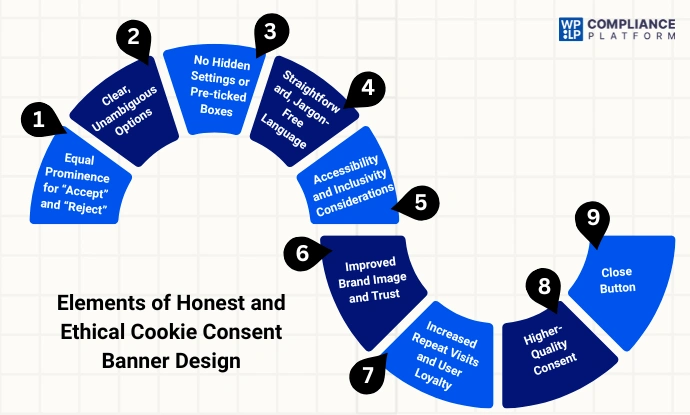
1. Equal Prominence for “Accept” and “Reject”
The most basic principle of ethical consent design is to give equal weight to both options. This means they should be the same size, use the same color palettes, and be placed in similar positions on the same level of the banner.
The “Accept” button should not be a bright or clickable color, and the “Reject” button should not be a light, gray, faint color, as this is a subtle way to nudge the user towards accepting cookies and not allow for a free choice.
2. Clear, Unambiguous Options
Users should not have to guess what their options are. The banner should allow for three card selections on the first layer.
Like the “Accept all” button means to agree to all cookies, “Reject all” means to decline all non-essential cookies, and “Manage Preferences” means to customize which specific cookies they are willing to accept.
This unambiguous arrangement eliminates ambiguity and provides users with immediate control over their data.
3. No Hidden Settings
An ethical banner will use no “pre-ticked boxes” for non-essential cookies – consent must be an unambiguous, affirmative act.
Furthermore, the “Manage Preferences” section should be easy to access and navigate.
It should clearly categorize cookies by purpose (e.g., necessary, performance, analytics, marketing) and allow users to toggle each category on or off with a simple click.
4. Straightforward, Jargon-Free Language
The copy on your banner and in the preferences panel should be easy for anyone to understand. Avoid legalistic jargon or overly technical terms.
Explain the purpose of each cookie category in plain language. For example, instead of “performance cookies,” you could say, “These cookies help us understand how our site is performing so we can make it better.”
5. Accessibility and Inclusivity Considerations
The Banner should be accessible and should be easy to understand. While using the color, a high color contrast ratio should be used between the text and background.
Navigation, including buttons and checkboxes, should be fully navigable using a keyboard alone.
And the banner’s code should be structured with proper ARIA labels (attributes in HTML that provide more accessible web content for users with disabilities) and alt text to be interpreted correctly by screen readers.
6. Improved Brand Image and Trust
If customers feel respected and empowered, they will trust your brand.
With a transparent and consumer-friendly banner, you can prove to customers that you value their privacy.
This can help enhance your brand image in the eyes of consumers who care about their privacy.
7. Increased Repeat Visits and User Loyalty
The first impression lasts, and therefore, a user who feels respected, rather than frustrated when they last viewed your site, is more likely to return as a user. When you make consent a respectful process, your user is more likely to return to your site.
8. Higher-Quality Consent
While an honest banner might result in a slightly lower opt-in rate for non-essential cookies, the consent you do receive is of much higher quality.
This genuine consent is legally valid and provides a stronger, more defensible basis for data processing, significantly reducing your risk of regulatory fines and legal challenges.
9. Close Button
A close button gives users an easy option to close the banner without giving consent, giving users the option to dismiss the banner if they do not want to give consent immediately.
However, some websites interpret the close button itself as implicit consent.
Meaning that if the user clicks on the close button or scrolls through the website without interacting with the banner, the cookies automatically load. This is a dark pattern and should be avoided.
Best Practices for Compliant, User-Friendly Consent UX
An effective banner does not trick users. It respects their choices. As a UX designer or business owner, it is your job to create interfaces that are transparent, ethical, and user-friendly.
So let’s look at how to avoid using dark patterns for cookie banners:
1. Clear and Equal Actions
Ensure your primary call-to-action buttons are balanced. The “Accept All” and “Reject All” (or “Decline”) buttons should be visually equal in size, shape, and color.
Avoid making the “Accept” button a vibrant color while the “Reject” button is a muted, almost-hidden link. Privacy UX builds trust through clear consent choices.
2. Avoid Manipulative Colors
Use a neutral color palette for your banner buttons. The goal is to present options impartially, not to psychologically “nudge” users toward a specific choice.
3. Explicit Purposes
Your banner should clearly state its purpose and what cookies are used for. The “Manage Preferences” section should provide a simple, layered approach where users can see and understand the purpose of each cookie category (e.g., “Strictly Necessary,” “Analytics,” “Marketing”) before making a decision.
Testing and auditing your cookie banner is also an essential step under best practices for compliance. You must regularly audit and test its performance. Here is how you can do it for your site.
- Cross-device and cross-browser functionality: Your banner must also function properly on all devices (desktop, tablet, mobile, etc.) and major browsers (Chrome, Firefox, and Safari). In addition to each of the devices or browsers functioning, you have to test for responsiveness to ensure the banner is always visible and can be interacted with, and does not block any necessary content.
- Multi-language testing: If your site has a global reach, your banner should support more than one language or translation. In addition to confirming the accuracy of the translations, you will want to check that the consent preferences are being applied properly, regardless of which language the user selects.
- Pre-consent blocking: Run a test to verify that non-essential cookies are not pre-checked in the user’s browser before they provide any consent. Use your developer tools to inspect your site and verify that no marketing or analytical cookies are fired until the user chooses to accept.
How WPLP Compliance Platform Enables Honest Consent
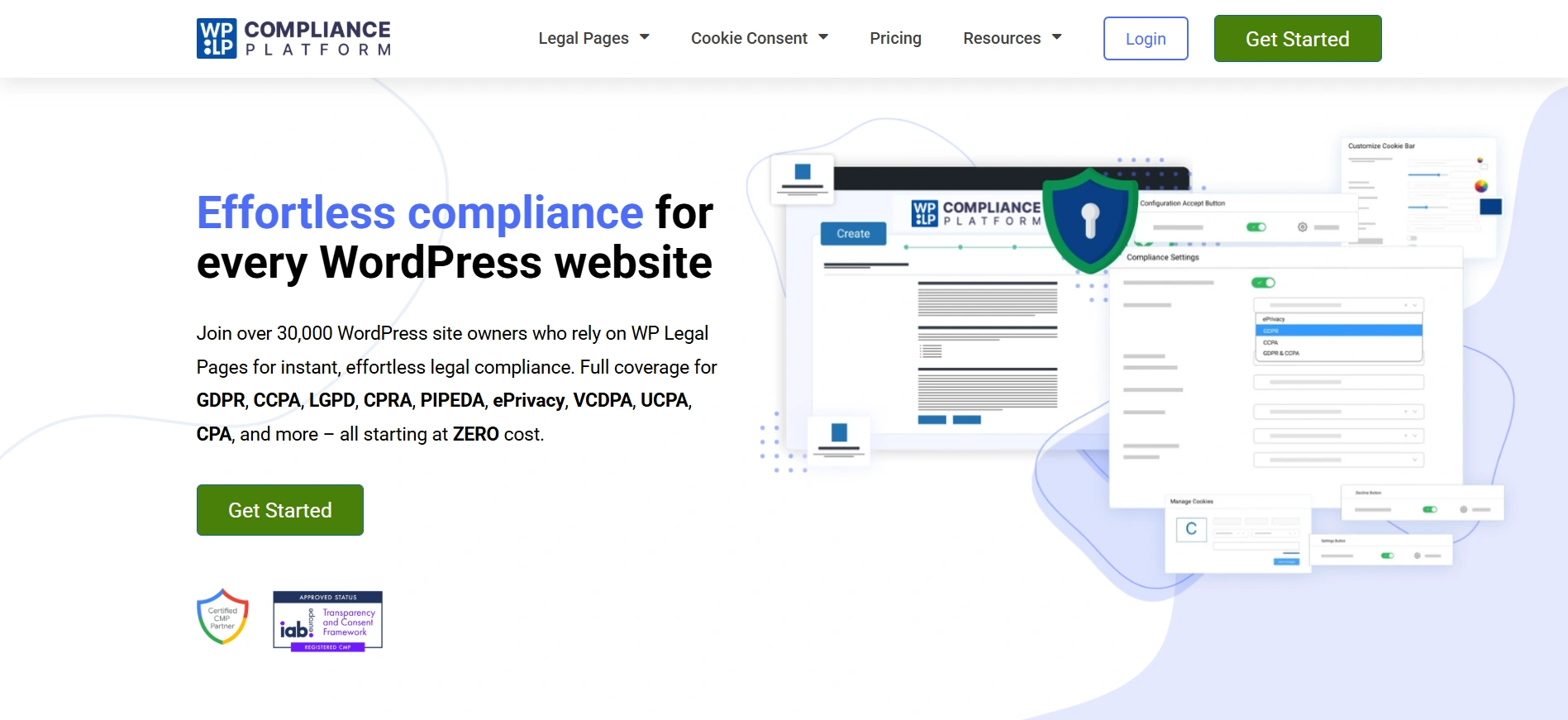
To put these principles into action, the WPLP Compliance Platform is designed around the belief that privacy should never come at the cost of user trust.
Instead of relying on manipulative “dark patterns,” WPLP ensures that consent collection is ethical, transparent, and stress-free.
Here is how the WPLP cookie consent manager supports honest consent:
1. Transparent, Customizable Banners
The platform provides a range of professional, pre-designed templates that are fully customizable. You can modify color, text, and arrangement to fit your brand, but be sure to have the primary features of ethical design, like equally sized “Accept” and “Reject” buttons. This means you can create a banner that looks great and aligns with your brand, without resorting to manipulative design.
2. Confirmed Opt-in and Opt-out, No Pre-ticked Boxes
The best part of our platform is the requirement for valid consent. WPLP ensures that all non-essential cookies are blocked by default. The banner is built to a “true opt-in” standard, which means users must take an explicit and overt action before any non-essential data is collected.
This functionality removes the most common dark pattern pre-ticked boxes and enforces that the consent you collect is valid in law.
3. Multilingual and Accessibility Support
WPLP allows you to serve customers on a global basis through its multilingual support and geo-targeting capabilities. It will show the relevant banner based on a user’s location, permitting you to comply with local laws.
The platform also includes accessibility best practices, meaning your consent banner is usable by all the visitors you target, regardless of their needs.
4. Ongoing Updates for Changing Legal/UX Best Practices
Privacy laws are constantly changing.
The WPLP Compliance Platform will keep you up-to-date with ever-changing privacy laws. It also ensures that you are updated with the latest UX best practices related to consent management.
And a good privacy UX makes compliance user-friendly.
5. Auto-Generate Cookie Banner
If you prefer not to think too much about the cookie banner and want an easy solution, WPLP also provides the option to auto-generate the cookie banner.
This feature is adopted to your website design and generates a cookie banner that aligns with your website with just one click.
WPLP allows you to comply without misleading users. With a fully functional and easy-to-use toolkit. It can help you create a responsible consent experience to safeguard your users and your company.
Real-World Examples: Dark Patterns vs. Honest Design
Example 1: The Visual Trickery
- Dark Pattern: A banner with a large, bright green “Accept All” button, and a small, grayed-out “Manage Preferences” link, with no visible “Reject” button.
- Honest Design: A banner with two equally-sized, equally-colored buttons: “Accept All” and “Reject All.” A third button, “Manage Preferences,” is also clearly visible.
Example 2: The Hidden Button
- Dark Pattern: A banner that only has an “Accept” button and a link that says “Learn More.” To reject cookies, the user must click “Learn More,” then navigate through several pages of settings, and then finally find a “Reject” button.
- Honest Design: A banner that offers a clear “Accept” and “Reject” button on the first layer. The “Manage Preferences” button leads directly to a panel where the user can easily toggle cookie categories.
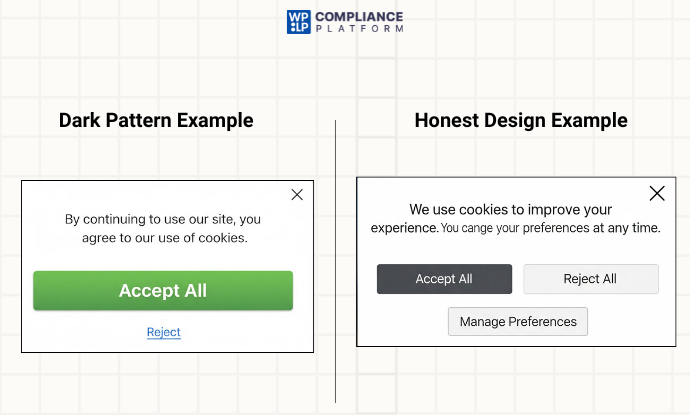
Frequently Asked Questions (FAQ)
A dark pattern is a deceptive design element on a cookie banner that manipulates users into giving consent they might not have intended to.
Yes, under regulations like GDPR, pre-ticked boxes are non-compliant. Consent must be a result of an explicit, affirmative action by the user.
A good first step is to check if your banner provides a clear and equally prominent option to “Reject All” cookies on the first layer. You should also ensure there are no pre-ticked boxes and the language is clear and unbiased.
A good consent manager should offer features like clear opt-in and opt-out options, no pre-ticked boxes, multi-language support, and a detailed preference center where users can granularly control their cookie choices.
Although an honest banner may lead to a slightly reduced opt-in rate for non-essential cookies, the consent you obtain is quality consent that is genuine and legal, and creates trust to build toward the future and helps you avoid fines.
Conclusion
The era of misleading cookie banners is ending. Designing for fair use and legitimate consent isn’t just about trying to earn compliance and avoid fines; it is a way to create a better Internet, for a better experience.
By embracing honesty and putting those values into your design, you will make a compliant banner that has a better chance of developing a brand’s honest relationship with your audience.
Have a question about your cookie banner? Leave a comment below!
Disclaimer: This article is for informational purposes only and does not constitute legal advice. For guidance on GDPR compliance and cookie consent practices, consult a qualified legal professional.
If you like this article, consider reading:
- Optimize Your Cookie Banner with A/B Testing (WPLP Compliance Platform)
- Geo-Targeting Cookie Banner: Smart Compliance Approach
- What Is A Cookie Banner And Why Do You Need One For Business
You don’t want to impact your brand and reputation, or compliance. Switch to WPLP Compliance Platform for transparent, ethical, and worry-free consent.
